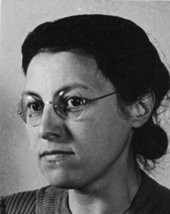Search for Names, Places and Biographies
Already layed Stumbling Stones
Suche
Kaatje Benninga * 1898
Billhorner Röhrendamm 117 (Hamburg-Mitte, Rothenburgsort)
HIER WOHNTE
DR. KAATJE BENNINGA
JG. 1898
FLUCHT HOLLAND
INTERNIERT WESTERBORK
DEPORTIERT 1943
SOBIBOR
ERMORDET 5.3.1943
Kaatje Benninga, born on 8 July 1898 in Hamburg, deported from the Netherlands to Sobibor, murdered on 5 Mar. 1943
In 1897, the Dutch cigar sales representative Simon Benninga and his wife Johanna, née Weinberg, born on 6 May 1870 in Rabber, settled in Hamburg. They probably joined the Jewish congregation immediately, since Mr. and Mrs. Benninga were members when the new tax file was created in 1913. By her marriage, Johanna Benninga acquired Dutch citizenship. Their long-standing residence at Rappstraße 22 saw the birth of their only daughter, Kaatje, on 8 July 1898. Nothing specific is known about her childhood, youth, and contacts to the Dutch relatives. She acquired skills in nursing during a stay in Paris, though completing her medical studies in Germany, where she concluded her medical training on 28 May 1923 by taking the medical examination in Hamburg. On 11 July 1924, she received her medical license. On 7 Aug. 1924, she was admitted to the Matrikel, the Directory of Hamburg Physicians, as number 286.
Kaatje Benninga was a member of the German-Israelitic Community and joined the orthodox Synagogue Association. She lived and practiced in Rothenburgsort, Billhorner Röhrendamm 117, as a general practitioner with statutory health insurance licensing and as a preferred provider for Welfare Services. Her landlord was the Rudolph-Karstadt-AG that ran an "Epa” outlet on the ground floor. With its low prices, the Epa, the one-price store, adjusted to the poverty of the population. Kaatje Benninga’s practice and living space were located on the raised ground floor adjacent to those of the neurologist Matzdorff. One may assume that she set herself up deliberately in the working-class neighborhood with its high maternal and infant mortality. In the early years of her work, her taxable income remained very low, but it increased in the years up to 1935, even though she had already lost her statutory health insurance license by 1933. At the same time, she was "retired from welfare practice,” something very distressful for her needy patients. The reasons for both the financial slump in 1935/36 and the economic recovery after the relocation to Grindelberg 7 are subject to conjecture.
It is unclear when her father, Simon Benninga, died. Mother Johanna gave up her apartment in June 1926, lived in furnished accommodations on Banksstraße in Hammerbrook, not far from her daughter, and from 1935 until her emigration to the Netherlands on 12 Aug. 1938 in the Grindel neighborhood.
Johanna Benninga moved in with relatives in Amsterdam. Kaatje arranged for the forwarding of moving goods that consisted merely of a few used garments and household items.
On 1 Oct. 1938, Kaatje Benninga was forced to end her work as a physician. Evidently, she ran a private practice for Jewish patients at her new address, Grindelberg 7, which once again secured her livelihood. Even before the end of 1938, she initiated her own emigration to the Netherlands, planning to take along her medical practice equipment. Her savings, which she had to reveal to the Chief Finance Administrator (Oberfinanzpräsident), were modest, and so was the value of her household and jewelry, which she had eagerly deposited in the steel safe-deposit box at her bank. She hoped to work initially as a caregiver in the Netherlands, for which she had acquired the necessary qualifications in Paris; it was not possible to determine whether she managed to realize this plan.
On 21 Jan. 1939, Kaatje Benninga followed her mother to Amsterdam. For the sake of old ties to Rothenburgsort, she commissioned the same company as for her mother’s moving goods, Julius Schumacher located in Billstraße.
Nothing is known about her life in the Netherlands. She was detained in the Westerbork transit camp, deported from there to Sobibor, and murdered on 5 Mar. 1943.
Translator: Erwin Fink
Kindly supported by the Hermann Reemtsma Stiftung, Hamburg.
© Hildegard Thevs
Quellen: 1; 2 FVg 2953, FVg 3564; 4; 5; StaH 552-1 Jüdische Gemeinden, 391; Joodsmonumen NL; Anton Kras, Joods Cultureel Kwariert, elektronische und telefonische Korrespondenz 27.9. bis 3.10.2018; Villiez, Anna von, Die Verdrängung der jüdischen Ärzte Hamburgs aus dem Berufsleben 1933-1945, Hamburg 2002; dies. Mit aller Kraft verdrängt. Göttingen 2009.
Zur Nummerierung häufig genutzter Quellen siehe Link "Recherche und Quellen".


